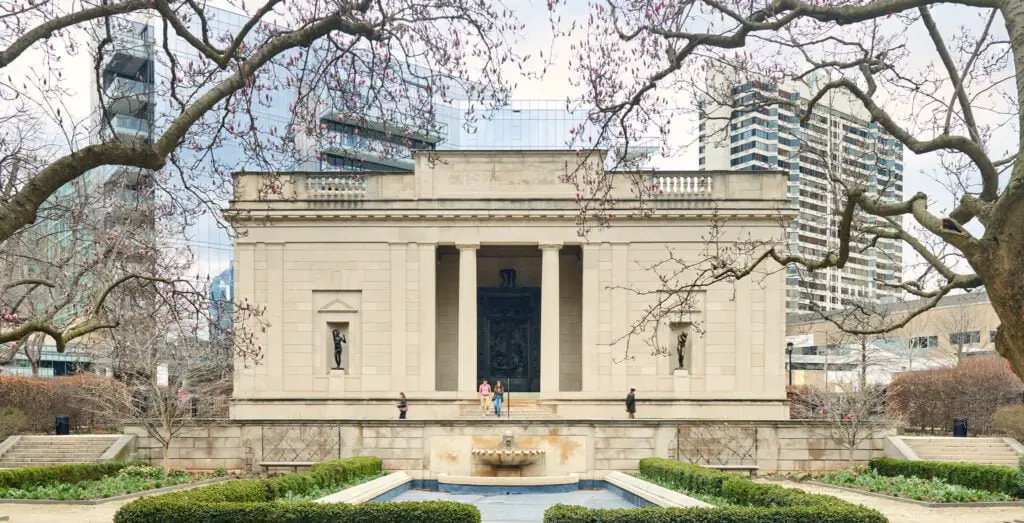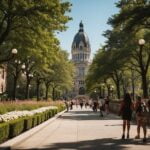Nestled amid the vibrant cultural landscape of Philadelphia, the Rodin Museum stands as a captivating testament to the enduring legacy of one of the world’s most celebrated sculptors, Auguste Rodin. Located on the iconic Benjamin Franklin Parkway, this museum is a sanctuary of artistic brilliance, housing a remarkable collection of Rodin’s masterpieces.
As visitors traverse the museum’s elegant halls and enchanting gardens, they embark on a journey through time, exploring the profound impact of Rodin’s sculptures on the world of art. With its rich history, exquisite surroundings, and a curated selection of iconic works, the Rodin Museum beckons art enthusiasts and curious minds to delve into the profound beauty and thought-provoking depth of Rodin’s artistic genius.
To learn what other Visitors say about the Rodin Museum check here on TripAdvisor (Affiliate Link)
Table of Contents
Collection Highlights
At the Rodin Museum in Philadelphia, the visitor is welcomed into a sanctuary of sculptural mastery, where the air is infused with the spirit of Auguste Rodin’s unparalleled creativity. The museum proudly houses one of the most extensive collections of Rodin’s works outside of France, a curated ensemble that brings to life the evolution of his artistic vision.
Dominating the landscape is the iconic presence of “The Thinker,” an emblematic masterpiece that invites contemplation and introspection. This powerful bronze figure, seated in profound reflection, encapsulates the intellectual depth that defines Rodin’s oeuvre.
Venturing further, visitors encounter the monumental “Gates of Hell,” a magnum opus that stands as a testament to Rodin’s lifelong exploration of human emotion and the human form. This intricate composition, adorned with a multitude of sculptural details, unfolds a narrative inspired by Dante’s “Inferno,” inviting observers to unravel the layers of symbolism embedded within.
“The Burghers of Calais” stands as another poignant highlight, capturing a moment of sacrifice and heroism. This emotionally charged ensemble of figures, each distinct in their expression, tells the tale of six citizens who offered themselves as hostages during the Hundred Years’ War. The visceral intensity and humanity in these sculptures reveal Rodin’s ability to infuse cold bronze with warmth and life.
Throughout the museum’s elegantly landscaped gardens, visitors encounter an array of Rodin’s smaller yet equally compelling works. From “The Age of Bronze” to “The Eternal Springtime,” each piece exemplifies Rodin’s mastery in capturing the nuances of human emotion, movement, and form.
The Rodin Museum’s collection, carefully curated and thoughtfully presented, provides a comprehensive overview of the artist’s evolution and the themes that captivated his imagination. It is an immersive journey through the mind of a sculptor who redefined the boundaries of his craft, leaving an indelible mark on the world of art.
The Thinker: A Symbolic Odyssey
As visitors approach the Rodin Museum in Philadelphia, their gaze is immediately drawn to the commanding presence of “The Thinker.” Perched contemplatively on a pedestal, this iconic bronze sculpture serves as the quintessential embodiment of intellectual prowess and introspection.
Crafted by Auguste Rodin as part of his magnum opus, “The Gates of Hell,” The Thinker captivates observers with its imposing stature and meticulous detailing. The figure, seated with head cradled by one hand while the other supports the chin, exudes an air of profound contemplation. The sinewy muscles, chiseled form, and furrowed brow reveal the intensity of thought encapsulated within this timeless masterpiece.
Rodin originally conceived The Thinker as a representation of the poet Dante Alighieri, pondering the intricacies of hell as described in his “Divine Comedy.” However, over time, the sculpture transcended its literary origins, becoming a universal symbol of human contemplation and the eternal quest for knowledge.
As one circumnavigates the sculpture, the play of light and shadow accentuates the dynamic composition, casting a visual symphony that enhances the depth of emotion captured in the bronze. The Thinker invites viewers to engage in a silent dialogue, encouraging reflection on the complexities of the human condition, the pursuit of wisdom, and the eternal struggle of the intellect.
Beyond its artistic significance, The Thinker has become an emblem of philosophy and intellectual inquiry, resonating across cultures and generations. Its timeless presence at the Rodin Museum in Philadelphia serves as a testament to the enduring power of Rodin’s vision and the universal human pursuit of understanding, making it a must-see highlight for visitors seeking a profound connection with art and thought.
The Gates of Hell: A Monumental Ode to Human Emotion
Among the crowning jewels of the Rodin Museum in Philadelphia, “The Gates of Hell” stands as an awe-inspiring testament to Auguste Rodin’s artistic genius. Conceived as a monumental sculptural group, this masterwork invites visitors to embark on an emotional odyssey through the intricate tapestry of human experience.
Inception and Inspiration: Conceived in 1881, “The Gates of Hell” was originally commissioned as a decorative feature for a decorative arts museum in Paris. Although the museum project was never completed, Rodin continued to work on this ambitious composition for over 37 years, making it a dynamic repository of his evolving ideas and creative expressions.
A Pantheon of Characters: As observers delve into the intricacies of “The Gates of Hell,” they encounter a captivating array of characters, each with its own unique narrative. From the tormented figures writhing in the depths of despair to the heroic souls embodying resilience and sacrifice, Rodin’s characters transcend their sculptural forms to become vessels of profound emotion and human complexity.
The Thinker and The Kiss: Notable elements within this colossal composition include the iconic figure of “The Thinker,” positioned at the top of the gates, serving as a contemplative guardian overseeing the narrative below. Equally enchanting is “The Kiss,” a passionate and tender depiction of lovers entwined, capturing a moment of both ecstasy and tragedy.
Emotional Resonance: Rodin’s genius lies in his ability to infuse cold bronze with warmth and life. The tactile quality of the sculpted surfaces and the expressive dynamism of the figures convey a spectrum of emotions, from anguish and despair to love and transcendence. The Gates of Hell serves as a visual symphony, echoing the depth and complexity of the human experience.
Legacy and Influence: “The Gates of Hell” has left an indelible mark on the world of art, inspiring subsequent generations of sculptors and artists. Beyond its sheer size and technical brilliance, the composition serves as a timeless exploration of the human condition, inviting viewers to reflect on the universal themes of life, death, and the indomitable spirit of humanity.
As visitors stand before this monumental masterpiece at the Rodin Museum, they are transported into a realm where art and emotion converge, inviting them to explore the profound depths of Rodin’s imagination and the collective essence of the human soul.
The Burghers of Calais: A Poignant Tribute to Heroism
Nestled within the Rodin Museum’s curated collection, “The Burghers of Calais” emerges as a poignant testament to both artistic brilliance and the indomitable spirit of sacrifice. Auguste Rodin’s masterful sculptural ensemble, created between 1884 and 1889, immortalizes a pivotal moment in the history of the Hundred Years’ War, capturing the collective courage and humanity of six citizens from the besieged city of Calais.
Historical Inspiration: The genesis of “The Burghers of Calais” lies in the siege of Calais during the Hundred Years’ War (1346-1353) between England and France. In a selfless act to save their city, six prominent citizens, known as burghers, volunteered to surrender themselves to the English king, Edward III, who had demanded their lives as a condition for sparing the city. Rodin, drawn to the emotional weight of this historical episode, envisioned a sculptural composition that would transcend its specific context to convey timeless themes of heroism and sacrifice.
Expressive Individuality: As one navigates the sculptural group, the individuality of each burgher comes to life. Rodin masterfully captures the raw emotions etched across their faces—anguish, determination, and acceptance. The contours of their bodies reflect the physical and emotional toll of their self-imposed sacrifice, while their gaunt, expressive forms tell a compelling story of resilience in the face of impending doom.
Narrative Composition: “The Burghers of Calais” is a dynamic tableau, with each figure contributing to the collective narrative. The viewer is invited to walk among the six burghers, gaining intimate insights into their internal struggles and the communal bond that unites them. The placement of the figures on an elevated platform enhances the dramatic impact, creating a sense of gravity and solemnity befitting the historical significance of the event.
Symbolism and Legacy: Beyond its historical roots, Rodin’s composition resonates as a universal symbol of sacrifice, courage, and the human capacity to endure in the face of adversity. “The Burghers of Calais” has inspired countless artists and continues to be revered for its emotional potency, reinforcing Rodin’s ability to transcend time and capture the essence of the human experience.
As visitors stand before this sculptural masterpiece at the Rodin Museum, they are transported to a moment of profound historical reflection, where the spirit of heroism and selflessness is immortalized in the enduring embrace of bronze.
Enchanting Gardens: A Tranquil Oasis Surrounding Rodin’s Masterpieces
The Rodin Museum in Philadelphia is not only a haven for sculpture enthusiasts but also a serene retreat for those seeking solace amidst nature’s beauty. The museum’s enchanting gardens, meticulously landscaped and thoughtfully designed, provide a harmonious backdrop to the bronze masterpieces of Auguste Rodin, creating an immersive experience that engages the senses.
Scenic Beauty: The moment visitors step into the museum’s gardens, they are greeted by a lush panorama of greenery, blooming flowers, and winding pathways. The verdant setting serves as a canvas for Rodin’s sculptures, offering a natural stage where art and nature coalesce in perfect harmony. Whether bathed in the soft glow of dawn or under the golden hues of sunset, the gardens provide an ever-changing tableau that complements the timeless quality of Rodin’s creations.
Strategic Placement of Sculptures: Rodin’s sculptures are strategically positioned throughout the gardens, inviting guests on a leisurely stroll punctuated by moments of discovery. As visitors meander along the pathways, they encounter iconic works such as “The Thinker” and “The Burghers of Calais,” seamlessly integrated into the landscape. This deliberate placement encourages an intimate and contemplative interaction with each sculpture, fostering a connection between art and the natural world.
Quiet Contemplation: The gardens at the Rodin Museum offer a respite from the hustle and bustle of urban life. Shaded alcoves, inviting benches, and secluded corners provide spaces for quiet contemplation. Whether visitors are seeking a moment of reflection or engaging in spirited conversations about art, the garden setting enhances the overall museum experience, inviting a deeper connection with Rodin’s work.
Seasonal Delights: The ever-changing seasons paint the gardens with a kaleidoscope of colors and textures. Spring brings a burst of blossoms, summer bathes the surroundings in vibrant hues, autumn transforms the foliage into a tapestry of gold and crimson, and winter adds a serene layer of tranquility. The gardens, like the sculptures they cradle, become a dynamic element that evolves with the passage of time.
Café and Al Fresco Dining: Nestled within this verdant oasis is the museum’s café, providing a delightful spot for visitors to relax and savor the ambiance. The option for al fresco dining allows patrons to enjoy a meal surrounded by the beauty of nature, creating a sensory experience that complements the visual feast offered by Rodin’s sculptures.
In essence, the gardens at the Rodin Museum serve as a living testament to the belief that art, when embraced by nature, transcends the confines of a gallery space. It is an invitation to explore, contemplate, and find serenity amid the exquisite interplay of sculpture and the natural world.
Enlightening Experiences: Educational Programs at the Rodin Museum
Beyond its role as a repository of artistic masterpieces, the Rodin Museum in Philadelphia takes pride in fostering a dynamic learning environment through its diverse array of educational programs. Designed to engage visitors of all ages and backgrounds, these initiatives aim to deepen understanding, spark curiosity, and cultivate a lasting appreciation for the transformative power of Auguste Rodin’s sculptures.
Guided Tours: Guided tours at the Rodin Museum offer an immersive exploration of the artist’s life, creative process, and the historical context surrounding his work. Knowledgeable docents lead visitors through the museum’s galleries and gardens, providing insights into the stories behind each sculpture and elucidating the nuances of Rodin’s artistic vision. These tours cater to both novices and seasoned art enthusiasts, creating an enriching experience for diverse audiences.
Lectures and Talks: Engaging lectures and talks are a cornerstone of the museum’s educational offerings. Renowned scholars, art historians, and experts in the field share their insights into Rodin’s contributions to sculpture, the cultural climate of his time, and the enduring relevance of his work. These events foster a deeper intellectual connection to the art on display, encouraging visitors to explore the broader artistic and historical contexts that influenced Rodin’s creations.
Hands-On Workshops: For those who crave a more hands-on experience, the Rodin Museum provides interactive workshops that invite participants to explore their own creativity. From sculpture classes to tactile art sessions, these workshops allow attendees to channel their inner artist, gaining a newfound appreciation for the challenges and joys of sculpting. Such interactive programs cater to both children and adults, creating a space for artistic expression and discovery.
Educational Outreach: The museum extends its educational mission beyond its physical walls, reaching out to schools and community groups. Educational outreach programs bring Rodin’s art into classrooms, fostering a connection between students and the masterpieces. These initiatives often include curriculum-based activities, guided discussions, and opportunities for students to create their own works of art inspired by Rodin’s techniques.
Special Exhibitions and Events: The Rodin Museum regularly hosts special exhibitions and events that complement its permanent collection. These thematic presentations delve into specific aspects of Rodin’s work, showcasing lesser-known pieces, exploring thematic connections, or highlighting his influence on contemporary art. Such exhibitions provide a dynamic platform for continued learning and discovery.
Digital Learning Resources: In an era of digital connectivity, the Rodin Museum embraces technology to extend its educational reach. Online platforms offer virtual tours, educational videos, and interactive resources that enable individuals to explore Rodin’s sculptures from the comfort of their homes. These digital tools serve as valuable supplements to on-site experiences, making art education accessible to a global audience.
The Rodin Museum’s commitment to educational programs reflects its dedication to democratizing art appreciation and fostering a lifelong love for creativity and learning. By providing diverse avenues for engagement, the museum ensures that visitors of all backgrounds can unlock the rich tapestry of artistic expression woven by Auguste Rodin.
Beyond Masterpieces: Special Exhibitions and Events at the Rodin Museum
In its commitment to enriching the cultural landscape of Philadelphia, the Rodin Museum goes beyond its exceptional permanent collection by hosting a dynamic array of special exhibitions and events. These curated showcases add a layer of vibrancy, exploration, and contemporary dialogue to the timeless allure of Auguste Rodin’s sculptures.
Thematic Exhibitions: The Rodin Museum periodically unveils thematic exhibitions that delve into specific facets of Rodin’s oeuvre, presenting a focused exploration of his artistic evolution. Whether highlighting a particular period in his career, examining recurring motifs, or shedding light on lesser-known works, these exhibitions offer visitors a fresh perspective on the sculptor’s genius. Themes may range from Rodin’s fascination with movement and the human form to his experimentation with different materials.
Contemporary Perspectives: Special exhibitions at the Rodin Museum extend beyond the 19th-century context, bridging the gap between tradition and contemporary art. Collaborations with contemporary artists, sculptors, and multimedia creators provide a platform for dialogue and reinterpretation. By juxtaposing Rodin’s classics with modern artistic expressions, these exhibitions invite visitors to consider the enduring influence of the master sculptor on today’s creative landscape.
Cultural Collaborations: The museum frequently collaborates with other cultural institutions and organizations to create interdisciplinary exhibitions that transcend the boundaries of traditional art presentation. These collaborations may involve partnerships with theaters, music ensembles, or literary organizations, weaving together a rich tapestry of artistic expression. Visitors may find themselves immersed in a multi-sensory experience where Rodin’s sculptures converge with other art forms.
Lecture Series and Panel Discussions: The Rodin Museum invites scholars, curators, and thought leaders to share their expertise through lecture series and panel discussions. These events deepen the intellectual discourse surrounding Rodin’s work, exploring themes such as art history, cultural influences, and the broader implications of his legacy. Attendees gain valuable insights and engage in thought-provoking conversations that enhance their understanding of the sculptor’s impact.
Seasonal and Festive Events: The museum embraces the spirit of the seasons and cultural celebrations by organizing special events that captivate a diverse audience. Whether it’s an outdoor sculpture garden soirée, a holiday-themed exhibition, or a summer concert series, these events infuse the Rodin Museum with a festive atmosphere, attracting visitors who seek art-inspired entertainment in a dynamic and celebratory setting.
Educational Programs and Workshops: Special exhibitions often coincide with educational programs and workshops tailored to complement the featured theme. These interactive sessions provide visitors with a hands-on understanding of artistic techniques, historical contexts, and thematic nuances explored in the exhibitions. Such programs extend the educational mission of the museum, creating a holistic and immersive experience.
By embracing the dynamism of special exhibitions and events, the Rodin Museum ensures that each visit is a unique and evolving encounter with artistic expression. Whether delving into Rodin’s legacy or engaging with contemporary dialogues, these exhibitions breathe new life into the museum, inviting visitors to explore the boundless possibilities within the realm of sculpture and art.
Immersive Encounters: The Rodin Museum Visitor Experience
At the heart of Philadelphia’s cultural landscape, the Rodin Museum offers visitors not just a glimpse into the artistic genius of Auguste Rodin but an immersive journey through sculptural masterpieces within an enchanting setting. The visitor experience at the Rodin Museum is crafted to be more than a museum visit; it is an exploration of beauty, contemplation, and the profound connections that art can forge.
Tranquil Ambiance: From the moment visitors step onto the museum grounds, a sense of tranquility envelops them. The well-manicured gardens, dotted with Rodin’s sculptures, create a serene oasis in the heart of the city. The soothing ambiance sets the stage for a leisurely exploration, encouraging visitors to engage with the art at their own pace and savor each moment.
Intimate Encounters with Masterpieces: The museum’s layout and curation allow for intimate encounters with Rodin’s masterpieces. Sculptures like “The Thinker,” strategically placed in the gardens, invite contemplation. Visitors can navigate through the carefully arranged galleries, discovering the emotional depth and tactile brilliance of each piece. The seamless integration of indoor and outdoor spaces ensures a fluid, immersive experience.
Educational Opportunities: For those eager to delve deeper, the museum offers a variety of educational programs. Guided tours led by knowledgeable docents, lectures by experts, and hands-on workshops cater to diverse interests and learning styles. These educational opportunities enhance the visitor’s understanding of Rodin’s art, providing context and fostering a connection that goes beyond the visual appeal of the sculptures.
Café and Al Fresco Dining: The experience extends beyond the galleries with the museum’s café, providing a delightful space for relaxation. Nestled within the gardens, it offers an opportunity for al fresco dining, allowing visitors to reflect on their artful journey over a cup of coffee or a light meal. The café becomes a natural extension of the visitor experience, blending culinary delights with the aesthetic pleasures of the surroundings.
Seasonal Delights: The changing seasons bring a dynamic element to the visitor experience. Whether surrounded by the vibrant blossoms of spring, the lush greenery of summer, the warm hues of autumn, or the tranquility of winter, each season imparts a unique charm to the museum grounds. Visitors are treated to a visual feast that evolves with the passage of time.
Interactive Engagement: The Rodin Museum encourages interactive engagement. Visitors are not mere spectators; they are invited to touch, feel, and absorb the energy emanating from the sculptures. The museum’s commitment to creating a multisensory experience allows for a more profound connection between the viewer and the art.
Special Events and Exhibitions: The dynamic calendar of special events and exhibitions ensures that no two visits are alike. From thematic exhibitions to cultural collaborations and festive gatherings, the museum continuously reinvents itself, offering returning visitors fresh perspectives and novel encounters with Rodin’s work.
The Rodin Museum’s commitment to providing a rich and multifaceted visitor experience transcends the conventional museum visit. It is an invitation to embark on a sensory and intellectual journey, allowing each visitor to forge a personal connection with the timeless beauty and enduring legacy of Auguste Rodin’s sculptures.
Conclusion
In the heart of Philadelphia, the Rodin Museum stands as a testament to the enduring power of art, encapsulating the brilliance of Auguste Rodin’s sculptural masterpieces within an enchanting landscape. The visitor experience at this cultural gem transcends the traditional boundaries of museum engagement, offering a symphony of tranquility, education, and immersive encounters with timeless beauty.
As visitors traverse the well-manicured gardens, each step becomes a journey through history and emotion. The sculptures, strategically placed amid nature’s splendor, beckon contemplation and introspection. From the iconic “Thinker” to the evocative “Burghers of Calais,” Rodin’s creations become companions on a visual and intellectual exploration, inviting visitors to unravel the layers of human experience embedded within each piece.
The museum’s commitment to education transforms the visitor experience into a profound journey of discovery. Guided tours, lectures, and hands-on workshops provide a deeper understanding of Rodin’s artistic evolution, fostering connections that go beyond the aesthetic appreciation of the sculptures. The cafe, nestled within the gardens, becomes a haven for reflection, where the artful journey continues over shared moments and culinary delights.
Seasonal transitions add a dynamic element to the museum’s allure, ensuring that each visit is a unique encounter with nature’s beauty and Rodin’s craftsmanship. The changing hues of the surroundings mirror the timeless themes explored in the sculptures, creating a living canvas that evolves with the passage of time.
Interactive engagement allows visitors to not only observe but to touch, feel, and connect with the energy emanating from the bronze masterpieces. The museum’s commitment to creating a multisensory experience invites a profound connection between the viewer and the art, transforming passive observation into an intimate dialogue with Rodin’s genius.
The dynamic calendar of special events and exhibitions completes the narrative, ensuring that the Rodin Museum remains a living institution. Thematic showcases, cultural collaborations, and festive gatherings add layers of vibrancy, inviting both returning and first-time visitors to witness the ever-evolving conversation between tradition and modernity.
In conclusion, the Rodin Museum in Philadelphia stands not merely as a repository of art but as a sanctuary where the timeless tapestry of Rodin’s legacy is unveiled. It is a space where nature and sculpture harmonize, where education and contemplation intertwine, and where each visitor is invited to become a part of the enduring legacy woven by Auguste Rodin’s masterpieces. Through every season, every event, and every gaze upon “The Thinker,” the Rodin Museum remains a timeless destination—a beacon of artistic inspiration that transcends the boundaries of time and captivates the human spirit.







1 thought on “Rodin Museum – A Masterpiece Haven in Philadelphia”